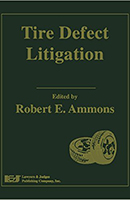 VERDICT: Touchdown!
VERDICT: Touchdown!
Tire Defect Litigation
By Robert E. Ammons (Tucson, AZ: Lawyers & Judges Publishing Co., 2016). 246 pgs. $99. Order, sales@lawyersandjudges.com.
Reviewed by Dick Ebbott
A potential client presents himself or herself after being involved in a serious accident that caused death or severe injuries. A vehicle was involved in the accident with evidence of a possible tire failure. One of the first things you should do, before deciding whether to take the case and who the potential client might have a claim against, is to get a copy of this book.
Editor Robert E. Ammons is not only the most knowledgeable and most successful attorney in tire defect litigation, he also has now edited this comprehensive book on the subject. Starting with a detailed explanation of how tires are built, Ammons takes readers through all aspects of the decision whether there is a case, who might be liable, how to prove the case, what the defense will do, and use of expert witnesses. He includes forms to use as invaluable tools during the litigation process.
Want to Review a Book?
Please request a book and writing guidelines from Wisconsin Lawyer managing editor Karlé Lester, at klester@wisbar.org or (608) 250-6127. Reviewers may keep the book reviewed. Reviews of about 500 words are due within 45 days of receiving the book. Reviews are published, space permitting, in the order received and may be edited for length and clarity.
The book is equally valuable if you are on the defense side of a tire defect case. Sure, Firestone might not be likely to hire you to represent them on a tire case, but what about the local garage that sold and mounted the tire or the car dealer that sold the car? Everyone having anything to do with the tire is going to be included. And if one of them is your client, get a copy of this book.
Did you know that a case can sometimes be made for “failure to warn” when a relatively new tire failed? The dealer that sold a new vehicle or a garage that sold a new tire might be held to know that the tire was three years old when they sold it and that it should be replaced after another three years, regardless of the number of miles driven or the tread wear. This book shows how to prove, in that instance, that 50 percent of the tire’s useful life was gone before the rubber even met the road.
The detailed explanation, photos, and diagrams in the first chapters provide a sound basis for asking good questions to decide if there is a case and, if there is, how to prove it. There are also chapters on government regulation, research, and recalls. Then Ammons gets into the nuts and bolts for the lawyer on deciding whether to take a case and what it will entail: theories of liability, who to sue, expert witnesses, testing, accident reconstruction discovery, and more are covered.
Ammons has enlisted the help of nine other experts who make valuable contributions. The annotations for further research on a particular topic are exhaustive. There is an appendix of abbreviations and acronyms to help wade through that morass, as well as a glossary. Finally, and perhaps most helpful of all, Ammons has provided 43 pages of sample forms to help with everything from complaint language to various protective orders.
If you’re thinking of taking a case that has a tire defect component, get a copy of the book to help you make a good decision. If you’re retained on either side of a case involving a tire defect, buy the book. It’s well worth it.
Dick Ebbott, U.W. 1967, practices mainly civil litigation in Flint, Mich. He has represented both plaintiffs and defendants in a variety of fields of litigation. He formerly was a Rock County assistant district attorney.
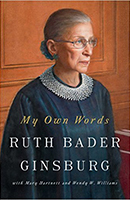 VERDICT: It’s a Keeper
VERDICT: It’s a Keeper
My Own Words
By Ruth Bader Ginsburg (New York, NY: Simon & Schuster, 2016). 371 pgs. $30. Order, www.amazon.com.
Reviewed by Jennifer Herzog
As I write this review, history has just been made in the case of Venezuela v. Helmerich. For the first time ever, more women than men participated in a U.S. Supreme Court argument. This is an occasion for which Justice Ruth Bader Ginsburg spent her life fighting, and it serves as a reminder of Justice Ginsburg’s role in changing the legal landscape for women. As such, there is no more appropriate time to read Justice Ginsburg’s story, as told by herself and others, in My Own Words.
This book is not the autobiography of Justice Ginsburg; rather, it is a curated collection of articles, essays, and speeches written by (and occasionally about) the distinguished justice. This format offers both advantages and drawbacks.
On one hand, the book is often insightful, inspirational, and outright entertaining. It weaves the backstory of Justice Ginsburg’s life into her collected works to create a framework for understanding her decisions and judicial philosophy. Embedded in this framework are personal anecdotes that are touching, amusing, and utterly fascinating (as are the photos included in the book, including one of the justice working out in her “Super Diva” sweatshirt). However, this format also contributes to an inconsistent narrative that can be redundant and disjointed. Stories are repeated, albeit in different contexts, and the organization is, at times, seemingly haphazard to the point that the book’s pacing is thrown off.
My strongest complaint, however, relates to the book’s endnotes. The authors elected to omit the majority of endnotes from the book’s text and instead place these references on a website in a format that is rather difficult to access and navigate (in fact, the references were completely inaccessible on my “latest and greatest” smartphone, the only type of electronic device most of us are likely to have nearby when reading). Perhaps as lawyers we overly fetishize citations, but I found this utterly maddening.
With that said, I still consider this book to be a “must read.” One needn’t be a lawyer, be liberal-minded, or otherwise identify with Justice Ginsburg to find this work interesting. Rather, this is a book for anyone who appreciates anecdotes on love, friendship, collegiality, professionalism, pioneering, and, above all, equality. I wouldn’t describe this collection as the type of nail-biter prose that you won’t be able to put down; however, it is the type of writing that you’ll want to come back to time after time. To that end, it makes an excellent addition to any library.
Jennifer Herzog, Illinois 2005, is university legal counsel at U.W.-Milwaukee.
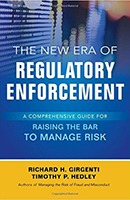 VERDICT: It’s a Keeper
VERDICT: It’s a Keeper
The New Era of Regulatory Enforcement: A Comprehensive Guide For Raising the Bar to Manage Risk
By Richard H. Girgenti & Timothy P. Hedley (New York, NY: McGraw Hill Education, 2016). 336 pgs. $59.50. Order, www.amazon.com.
Reviewed by Leonard W. Wang
The regulatory and compliance obligations of businesses have increased significantly in recent decades as the federal government has endeavored to address many of the great problems of our times. Financial fraud and crises, terrorism, international aggression, healthcare needs, and narcotics trafficking have led to greater regulation and enforcement.
TheNew Era of Regulatory Enforcement focuses on federal regulation in a number of topical areas, including 1) bribery and corruption; 2) money laundering; 3) economic and trade sanctions; 4) market manipulation and insider trading; 5) financial reporting fraud; 6) unfair, deceptive, and abusive consumer-finance practices; 7) the obligations of financial and similar institutions to help combat offshore tax evasion; 8) fraud and misconduct in health care; and 9) fraud and misconduct in life sciences. Each subject is covered by a separate chapter.
The book discusses ways to assess regulatory risk and offers a framework for managing such risk. The authors recommend that corporations appoint a chief compliance officer (CCO), placed at a senior level and supported by compliance staff. The board of directors would oversee the CCO, and internal auditors would assist the CCO.
The authors discuss policies and procedures for preventing undesired risks, including a corporate code of conduct, risk-specific prophylactic measures, systems for detecting misconduct and other risks, employee training, and due diligence in hiring. In addition, they examine potential responses to problems, including internal investigations, company-imposed sanctions, disclosure to regulators and the public, and remedial measures.
The book then discusses the selected subjects. Each chapter describes applicable regulatory requirements, potential sanctions and other consequences, and ways to structure compliance measures. Governmental enforcement programs are reviewed, and ways to resolve problems and disputes with the government are discussed. The material is generally quite informative (although the reference on page 153 to section 15(f) of the Securities Exchange Act of 1934 should be to section 15(g)).
Readers would have benefited from more discussion than the book provides of the human element as a source of business risks. Major compliance failures of the past two decades have often been linked to human frailty. Incentive compensation and other reward systems often play a crucial role in motivating misconduct, as demonstrated by the recent Wells Fargo Bank scandal in which millions of unauthorized customer accounts were created because the bank reportedly rewarded the “sale” of accounts.
In addition, the greatest compliance risks may reside at the highest levels. As seen in the Worldcom and Enron scandals, renegade CEOs and CFOs can cause far more damage than a middle-level executive. Effective compliance requires focusing on the human element.
The book provides a solid overview of regulatory risks and compliance. Creating actual compliance systems would require more detailed information than is provided in the book, along with the input of knowledgeable professionals. Overall, the book offers many valuable insights into the challenges of regulatory compliance in today’s complex business world.
Leonard Wang, U.W. 1978, practices in Falls Church, Va.
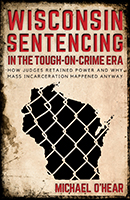 VERDICT: Not for Me, Maybe for You
VERDICT: Not for Me, Maybe for You
Wisconsin Sentencing in the Tough-on-Crime Era: How Judges Retained Power and Why Mass Incarceration Happened Anyway
By Michael O’Hear (Madison, WI: UW Press, 2017). 304 pgs. $44.95. Order, uwpress.wisc.edu/order.html.
Reviewed by Will Kramer
Wisconsin Sentencing in the Tough-on-Crime Era: How Judges Retained Power and Why Mass Incarceration Happened Anyway has a fascinating premise. The author, a professor at Marquette Law School, credits broad sociological works like Michelle Alexander’s bestselling The New Jim Crow but argues that the story of mass incarceration is too complex to boil down to one overarching cause. He posits that many people believe mandatory sentencing requirements such as California’s “Three Strikes” law are to blame for the explosion in the nation’s prison population but that Wisconsin’s experience disproves this notion. He hopes that, by explaining the unique aspects of Wisconsin’s journey, his book will assist reformers in their efforts to undo mass incarceration.
Unfortunately, the book does not live up to its title. In an unwieldy sentence from the concluding chapter, the author provides his answer to the title’s question: “Wisconsin’s prison population exploded because serious violent crime exploded and because an increasingly populist environment made it politically desirable, perhaps even necessary, for judges and prosecutors to get tougher, while also discouraging the development and use of community-based alternatives to imprisonment.”
This conclusion demonstrates a fallacy in the book’s framing: despite repeatedly noting that it is “common wisdom” that mandatory minimum sentences are to blame for mass incarceration and that therefore increased judicial discretion is the answer, this argument is a strawman. It does not require any great leap of imagination to understand that political pressure to appear “tough on crime” is an underlying cause of mandatory minimum laws and harsh judicial sentencing decisions. Without providing evidence that the mistaken “common wisdom” actually exists, the book provides an unsatisfying answer to an irrelevant question nobody was asking.
Additionally, although the author acknowledges the extreme disparities in imprisonment by race in Wisconsin and elsewhere, his almost complete lack of attention to that subject is unforgivable.
Worse, he offers the following disproven and patently offensive explanation for his lack of focus on this issue: “[T]he mere existence of a racial disparity does not necessarily prove that racism is playing an important role in driving mass incarceration. For instance, elevated rates of black imprisonment could conceivably result from higher rates of offending.” This disturbing attitude is especially disappointing because the role of racism could have offered an important answer to the book’s titular question as to why increased judicial discretion does not prevent mass incarceration.
Despite these weaknesses, the book will have value to its appropriate audience. It provides an interesting history of the evolution of Wisconsin’s sentencing framework since the 1970s. Scholars and historians will certainly appreciate the diligence with which the author conducted his research. The author would have done better to properly frame this work as a historical analysis targeted at those specific audiences rather than trying to ride Michelle Alexander’s coattails toward popular appeal. Anyone hoping for a Wisconsin-specific version of The New Jim Crow will be severely disappointed.
Will Kramer is a former investigator with a U.S. Senate oversight committee and risk management consultant to businesses across the country. He is currently a law student at the University of Wisconsin. He writes regularly at SolidarityLaw.com.
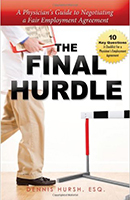 VERDICT: Not for Me, Maybe for You
VERDICT: Not for Me, Maybe for You
The Final Hurdle: A Physician’s Guide to Negotiating a Fair Employment Agreement
By Dennis Hursh (Charleston, S.C.: Advantage, 2012). 116 pgs. $69.97. Order, www.amazon.com.
Reviewed by David A. Johnson Jr.
The Final Hurdle provides an overview of the key negotiable clauses in physician employment agreements. At the outset, it is important to note that this book is written by a lawyer for physicians and is relatively elementary in nature. A newer lawyer negotiating his or her first physician employment agreement, however, may find the practical advice and discussion of key terminology helpful.
The Final Hurdle begins with an overview of a physician employment agreement. The book then focuses on the major components of such agreements, including physician compensation, restrictive covenants, working conditions, malpractice insurance, and becoming an equity partner in the physician’s practice group.
The author’s discussion of the options available to a physician for compensation would be useful to anyone unfamiliar with the topic. The Final Hurdle discusses the common compensation structures, as well as the background needed to understand these structures, including key terms such as relative value units (RVUs) and the manner in which sign-on bonuses are structured. The chapter concerning a physician’s path to becoming an equity partner is also informative. The author explains the different valuation methods for determining the purchase price for the equity, as well as when ownership in the practice should be expected.
Much like the other chapters, the chapters discussing restrictive covenants and malpractice insurance are cursory in nature, and they tend to also provide a general overview of the key terms related to these topics.
The Final Hurdle especially falls short on legal analysis. Restrictive covenants and insurance, especially in the medical context, can be nuanced and complex. The Final Hurdle offers no authority for its legal assertions and attempts to apply to all physicians, regardless of location, preventing a discussion of state-specific rules. This generality leads to generic advice, with which a local lawyer may disagree.
Notwithstanding these drawbacks, The Final Hurdle does provide good practical advice. Throughout the book, the author does a nice job of interweaving practical advice with the topic discussed.
While at times the author’s stories seem more like a commercial for his services than advice, the last chapter, titled “The Wisdom of Experience,” provides real-world advice ranging from the potential impact of employment termination on the physician’s immigration status to tips on negotiating the buy-in price when becoming a partner in the practice group. These tips reflect the experience of an experienced practitioner and would help a physician understand the purpose for negotiation.
Overall, this book is good for its target market: physicians. This book is written in a conversational tone, without the legalese that appeals to some lawyers but might bore physicians. Lawyers would be better served finding a technical analysis of the topic for their own use. The book, however, would make a great gift to a friend graduating from medical school or a gift to a client.
David A. Johnson Jr., Case Western Reserve 2009, is in practice with Piccione, Keeley & Associates Ltd. in Wheaton, Ill.
